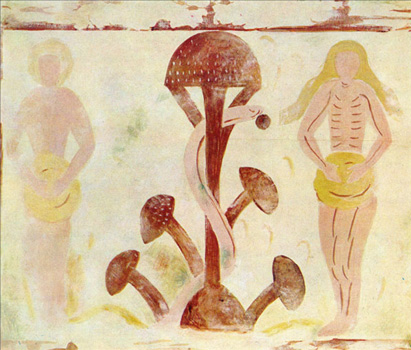Black,
http://en.wikipedia.org/wiki/Entheogenic_drugs_and_the_archaeological_record#Soma_and_Mushrooms
Entheogenic Drugs and Major World Religions
There have been several reports stating that the Bible and the Vedas have several references to entheogenic drugs. Although most scholars largely reject these claims, they are accepted by many fringe groups.
[edit] Manna and Mushrooms
Some researchers speculate that Manna, the food that which the Israeli tribes harvest, was actually an entheogenic drug. The Bible as quoted in Exodus 16:14 reads:
“And when the dew that lay was gone up, behold, upon the face of the wilderness there lay a small round thing, as small as the hoar frost on the ground. And when the children of Israel saw it, they said one to another, It is manna: for they wist not what it was. And Moses said unto them, This is the bread which the Lord hath given you to eat.”
Some point to the similarities of Psilocybe and the biblical Description of Manna as evidence.
[edit] Soma and Mushrooms
In the Vedas, the religious texts of the Hindu religion, there has been a lot of speculation on the nature of what Soma, the food of the gods, actually was. Below is a passage from the Vedas "Splendid by Law! declaring Law, truth speaking, truthful in thy works, Enouncing faith, King Soma!... O [Soma] Pavamana, place me in that deathless, undecaying world wherein the light of heaven is set, and everlasting lustre shines.... Make me immortal in that realm where happiness and transports, where joy and felicities combine..." Scholars like R.G. Wasson suggest that Soma is Fly Agaric, a mushroom commonly used by Siberian Shamans.
http://www.answers.com/topic/entheogen
Judaism and Christianity
According to The Living Torah, cannabis was an ingredient of holy anointing oil mentioned in various sacred Hebrew texts. [ 5 ] The herb of interest is most commonly known as kaneh-bosm (Hebrew: ?????-??????). This is mentioned several times in the Old Testament as a bartering material, incense, and an ingredient in holy anointing oil used by the high priest of the temple. Although Chris Bennett's research in this area focuses on cannabis, he mentions evidence suggesting use of additional visionary plants such as henbane, as well. [ 6 ]
The Septuagint translates kaneh-bosm as calamus, and this translation has been propagated unchanged to most later translations of the old testament. However, Polish anthropologist Sula Benet published etymological arguments that the Aramaic word for hemp can be read as kannabos and appears to be a cognate to the modern word 'cannabis', [ 7 ] with the root kan meaning reed or hemp and bosm meaning fragrant. Both cannabis and calamus are fragrant, reedlike plants containing psychotropic compounds.
Although philologistJohn Marco Allegro has suggested that the self-revelation and healing abilities attributed to the figure of Jesus may have been associated with the effects of the plant medicines [from the Aramaic: "to heal"], this evidence is dependent on pre-Septuagint interpretation of Torah and Tenach, and goes firmly against the accepted teachings of the Holy See. However Merkur contends that a minority of Christian hermits and mystics could possibly have used entheogens, in conjunction with fasting, meditation and prayer. [citation needed]
Allegro was the only non-Catholic appointed to the position of translating the Dead Sea scrolls. His extrapolations are often the object of scorn due to Allegro's non-mainstream theory of Jesus as a mythological personification of the essence of a "psychoactive sacrament", furthermore they conflict with the position of the Catholic Church in regards to transubstantiation and the teaching involving valid matter, form, and substance—that of bread and wine, which do not contain psychoactive substances. Allegro's book, The Sacred Mushroom and the Cross, relates the development of language to the development of myths, religions and cultic practices in world cultures. Allegro believed he could prove, through etymology, that the roots of Christianity, as of many other religions, lay in fertility cults; and that cult practices, such as ingesting visionary plants (or "psychedelics") to perceive the Mind of God [Avestan: Vohu Mana], persisted into the early Christian era, and to some unspecified extent into the 1200s with reoccurrences in the 1700s and mid 1900s, as he interprets the Plaincourault chapel's fresco to be an accurate depiction of the ritual ingestion of Amanita muscaria as the Eucharist.
The historical picture portrayed by the Entheos journal is of fairly widespread use of visionary plants in early Christianity and the surrounding culture, with a gradual reduction of use of entheogens in Christianity. [ 8 ] R. Gordon Wasson's book Soma prints a letter from art historian Erwin Panofsky asserting that art scholars are aware of many 'mushroom trees' in Christian art. [ 9 ]
The question of the extent of visionary plant use throughout the history of Christian practice has barely been considered yet by academic or independent scholars. The question of whether visionary plants were used in pre-Theodosius Christianity is distinct from evidence that indicates the extent to which visionary plants were utilized or forgotten in later Christianity, including so-called "heretical" or "quasi-" Christian groups, [ 10 ] and the question of other groups such as elites or laity within "orthodox" Catholic practice. [ 11 ]
James Arthur asserts that the little scroll from the angel with writing on it referred to in Ezekiel 2: 8,9,10 and Ezekiel 3: 1,2,3 and Book of Revelation 10: 9,10 was the speckled cap of the Amanita muscaria mushroom. [ 12 ]
Cultural use
Alexander Shulgin World Famous Developer of Pyschedelic Drugs:
http://www.jehovahs-witness.net/jw/friends/90284/1/Interview-Alexander-Shulgin-World-Famous-Developer-of-Pyschedelic-Drugs
